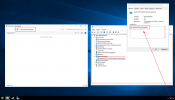Hi everyone,
are there any known issues with networking inside Windows VMs and Proxmox 7?
2 days ago i installed a Windows Server 2016 VM without any problems.
Yesterday i did an upgrade of the Proxmox Cluster from latest 6 to 7.0-8.
Today i try to install a Windows Server 2016 VM (same ISO, same procedure, same virtio version 0.1.190) and the VM doesn't recognize the Network adapter although the virtio drivers are installed and Windows says that the device is working fine. Still the network connections panel is empty.
I tried different network devices (e1000, virtio) and machine types (pc-i440fx-5.2, pc-i440fx-6.0)
It doesn't make any sense to me.
are there any known issues with networking inside Windows VMs and Proxmox 7?
2 days ago i installed a Windows Server 2016 VM without any problems.
Yesterday i did an upgrade of the Proxmox Cluster from latest 6 to 7.0-8.
Today i try to install a Windows Server 2016 VM (same ISO, same procedure, same virtio version 0.1.190) and the VM doesn't recognize the Network adapter although the virtio drivers are installed and Windows says that the device is working fine. Still the network connections panel is empty.
I tried different network devices (e1000, virtio) and machine types (pc-i440fx-5.2, pc-i440fx-6.0)
It doesn't make any sense to me.
Code:
# pveversion
proxmox-ve: 7.0-2 (running kernel: 5.11.22-1-pve)
pve-manager: 7.0-8 (running version: 7.0-8/b1dbf562)
pve-kernel-5.11: 7.0-3
pve-kernel-helper: 7.0-3
pve-kernel-5.4: 6.4-4
pve-kernel-5.11.22-1-pve: 5.11.22-2
pve-kernel-5.4.124-1-pve: 5.4.124-1
pve-kernel-5.4.34-1-pve: 5.4.34-2
ceph: 16.2.4-pve1
ceph-fuse: 16.2.4-pve1
corosync: 3.1.2-pve2
criu: 3.15-1+pve-1
glusterfs-client: 9.2-1
ifupdown: residual config
ifupdown2: 3.0.0-1+pve6
ksm-control-daemon: 1.4-1
libjs-extjs: 7.0.0-1
libknet1: 1.21-pve1
libproxmox-acme-perl: 1.1.1
libproxmox-backup-qemu0: 1.2.0-1
libpve-access-control: 7.0-4
libpve-apiclient-perl: 3.2-1
libpve-common-perl: 7.0-4
libpve-guest-common-perl: 4.0-2
libpve-http-server-perl: 4.0-2
libpve-storage-perl: 7.0-9
libqb0: 1.0.5-1
libspice-server1: 0.14.3-2.1
lvm2: 2.03.11-2.1
lxc-pve: 4.0.9-2
lxcfs: 4.0.8-pve1
novnc-pve: 1.2.0-3
proxmox-backup-client: 2.0.1-1
proxmox-backup-file-restore: 2.0.1-1
proxmox-mini-journalreader: 1.2-1
proxmox-widget-toolkit: 3.2-4
pve-cluster: 7.0-3
pve-container: 4.0-7
pve-docs: 7.0-5
pve-edk2-firmware: 3.20200531-1
pve-firewall: 4.2-2
pve-firmware: 3.2-4
pve-ha-manager: 3.3-1
pve-i18n: 2.4-1
pve-qemu-kvm: 6.0.0-2
pve-xtermjs: 4.12.0-1
qemu-server: 7.0-9
smartmontools: 7.2-pve2
spiceterm: 3.2-2
vncterm: 1.7-1
zfsutils-linux: 2.0.4-pve1
Code:
# qm config 123
agent: 1
boot: order=virtio0;ide2;net0
cores: 2
ide0: hvshare:iso/virtio-win-0.1.196.iso,media=cdrom,size=486642K
ide2: hvshare:iso/SW_DVD9_Win_Svr_STD_Core_and_DataCtr_Core_2016_64Bit_German_-3_MLF_X21-30352.ISO,media=cdrom
machine: pc-i440fx-5.2
memory: 8192
name: test01
net0: virtio=FA:4C:DC:09:4B:42,bridge=vmbr0,firewall=1,tag=910
numa: 0
onboot: 1
ostype: win10
scsihw: virtio-scsi-pci
smbios1: uuid=6728accf-234d-4a51-abac-8b9934ff5b1a
sockets: 1
virtio0: hdd:vm-123-disk-0,size=50G
vmgenid: b629511a-a4ae-434f-9465-3d04ecba9db6Attachments
Last edited:



